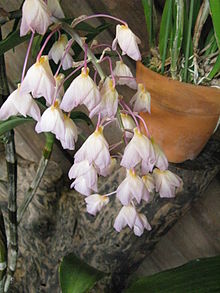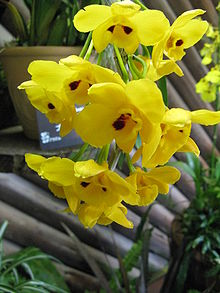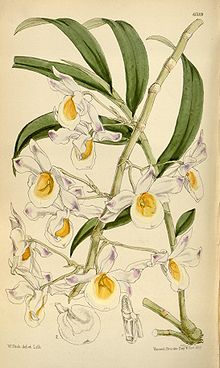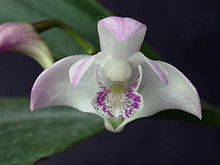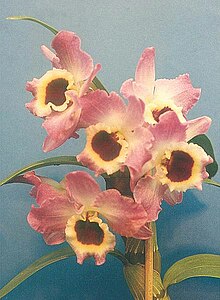You are here
Orchidaceae
Dendrobium
EOL Text
Dendrobium orchids are found throughout the western Pacific and east Asia from as far north as Japan to as far south as Tasmania and southern New Zealand, east to Tahiti and west to western India (Lavarack et al. 2000). The genus (as currently delineated) includes more than a thousand species found in widely varying habitats (Lavarack et al. 2000; Adams et al. 2006). Like most other epiphytes, Dendrobium orchids are restricted to areas of moderate to high rainfall (e.g., in tropical lowlands, annual rainfall of more than 150 cm and a dry season of less than 6 months; at higher elevations in the tropics, or in cooler temperate regions, drier conditions can be tolerated). Dendrobium are found from just above the treeline on the highest mountains to the branches of trees overhanging the ocean. They are absent from some of the drier forests and woodlands, deserts and semi-deserts, and alpine and other cold environments. They are mainly inhabitants of primary forest, especially the rainforests of Southeast Asia and New Guinea. Swamp forests (such as those dominated by Melaleuca species) and mangrove forests may also support large numbers of individuals and species. Relatively few Dendrobium species are found in monsoonal forests and woodlands, but populations of species that do occur in these habitats can be dense. The small number of species found in the subalpine shrubbery of tropical mountains are of particular interest in that most of them have brightly colored flowers. Some species are well adapted to disturbed habitats. (Lavarack et al. 2000)
As a consequence of the fact that the genus includes many species that are generally compact, fabulously colorful, and often easy to grow, Dendrobium are among the most horticulturally important orchids. Given the great range of habitats and altitudes at which various species grow, some appropriate species can be found for cultivation in most climates. Although there are many rare and endangered species, Dendrobium are common in both the wild and in gardens in southern Asia; the Malesian Islands (i.e., the islands to the east of Southeast Asia, including New Guinea), the Pacific Islands (the islands south and east of the Solomon Islands, the endemic-rich New Caledonia being the largest of these), and Australia. New Guinea has the greatest diversity of Dendrobium, both in number of species and in diversity per unit area. Lavarack et al. review the historical biogeography of Dendrobium. (Lavarack et al. 2000)
Dendrobium orchids vary in size from tiny creeping plants less than a centimeter high (e.g., D. toressae) to clumped bamboo-like plants several meters tall (e.g., D. discolor). Although most are epiphytes, some grow on rocks or on the ground. All Dendrobium (even the terrestrial species) have coarse, spreading root systems, unlike the tuberous root systems characteristic of terrestrial orchids from temperate regions. (Lavarack et al. 2000)
Dendrobium orchids typically produce large numbers of very small and easily dispersed seeds. These seeds contain almost no food reserves. Seedlings must quickly form mycorrhizal associations with appropriate fungi to supply them with needed nutrition as they develop. (Lavarack et al. 2000)
Perhaps a third of the 30,000 or so orchid species are deceptive, attracting pollinators but then failing to reward them with pollen or nectar. Many of these orchids imitate the scent of rewarding flowers or potential mates. However, one rewardless Dendrobium orchid, Dendrobium sinense, is pollinated by the hornet Vespa bicolor, which it apparently attracts by mimicking the alarm pheromone produced by honeybees, which hornets frequently hunt as food for their larvae (Brodmann et al. 2009).
| License | http://creativecommons.org/licenses/by-nc-sa/3.0/ |
| Rights holder/Author | Shapiro, Leo, Shapiro, Leo, EOL Rapid Response Team |
| Source | http://eolspecies.lifedesks.org/pages/63280 |
In Great Britain and/or Ireland:
Foodplant / spot causer
Cladosporium dematiaceous anamorph of Cladosporium orchidearum causes spots on live Dendrobium
| License | http://creativecommons.org/licenses/by-nc-sa/3.0/ |
| Rights holder/Author | BioImages, BioImages - the Virtual Fieldguide (UK) |
| Source | http://www.bioimages.org.uk/html/Dendrobium.htm |
Wang et al. (2009) developed inter-simple sequence repeat (ISSR) genetic markers for diagnosing species and studying genetic diversity in Dendrobium. Xue et al. (2010) constructed genetic linkage maps for two Dendrobium species using random amplified polymorphic DNA (RAPD) and sequence-related amplified polymorphism (SRAP) markers. These maps, which cover 92.7% and 82.7% of the D. hercoglossum and D. officinale genomes, respectively, should facilitate mapping of horticultural and medicinal traits (around 40 Dendrobium species have been used in traditional Chinese medicine) and be useful for marker-assisted selection in Dendrobium breeding programs.
| License | http://creativecommons.org/licenses/by-nc-sa/3.0/ |
| Rights holder/Author | Shapiro, Leo, Shapiro, Leo, EOL Rapid Response Team |
| Source | http://eolspecies.lifedesks.org/pages/63280 |
Barcode of Life Data Systems (BOLD) Stats
Specimen Records:1420
Specimens with Sequences:1344
Specimens with Barcodes:743
Species:247
Species With Barcodes:190
Public Records:1334
Public Species:185
Public BINs:0
Lavarack et al. (2000) review the history of orchid collecting and current conservation threats to orchids in the wild and discuss potential solutions to respond to these challenges.
| License | http://creativecommons.org/licenses/by-nc-sa/3.0/ |
| Rights holder/Author | Shapiro, Leo, Shapiro, Leo, EOL Rapid Response Team |
| Source | http://eolspecies.lifedesks.org/pages/63280 |
The pseudobulbs of D. canaliculatum and D. speciosum were used as food by the aboriginal Australians. Other Dendrobium species have been used for a range of culinary, medicinal, putative aphrodisiacs, and other purposes. Lavarack et al. (2000) review basic propagation techniques. (Lavarack et al. 2000)
| License | http://creativecommons.org/licenses/by-nc-sa/3.0/ |
| Rights holder/Author | Shapiro, Leo, Shapiro, Leo, EOL Rapid Response Team |
| Source | http://eolspecies.lifedesks.org/pages/63280 |
|
|
|
Dendrobium is a genus of orchids (Orchidaceae), containing about 1,200 species.
Several former species of Dendrobium are placed elsewhere today; see below for these.
A[edit]
B[edit]
C[edit]
D[edit]
E[edit]
F[edit]
G[edit]
H[edit]
I[edit]
|
|
J[edit]
- Dendrobium jabiense
- Dendrobium jacobsonii – Jacobson's Dendrobium
- Dendrobium jenkinsii – Jenkins's dendrobium
- Dendrobium jennae
- Dendrobium jennyanum
- Dendrobium johannis – Johan's dendrobium
- Dendrobium johnsoniae F.Muell. – Johnson's Dendrobium
- Dendrobium jonesii
- Dendrobium jonesii var. jonesii
- Dendrobium jonesii var. magnificum
- Dendrobium jubatum
- Dendrobium judithiae
- Dendrobium junceum – Reed-leaved Dendrobium
- Dendrobium juncifolium
- Dendrobium juncoideum
- Dendrobium juniperinum
K[edit]
L[edit]
M[edit]
N[edit]
O[edit]
P[edit]
Q[edit]
- Dendrobium quadrialatum[verification needed] J.J.Sm.
- Dendrobium quadriferum
- Dendrobium quadrilobatum
- Dendrobium quadriquetrum
- Dendrobium quinquecaudatum
- Dendrobium quinquedentatum
- Dendrobium quinquelobatum
- Dendrobium quisumbingii
R[edit]
S[edit]
T[edit]
U[edit]
- Dendrobium uliginosum
- Dendrobium umbonatum
- Dendrobium uncatum
- Dendrobium undatialatum
- Dendrobium unicarinatum
- Dendrobium unicum – Unique dendrobium
- Dendrobium uniflorum – Single-flowered Dendrobium
- Dendrobium × usitae
- Dendrobium usterioides
- Dendrobium ustulatum
- Dendrobium utile[verification needed]
V[edit]
W[edit]
|
X[edit]
- Dendrobium xanthoacron
- Dendrobium xanthogenium
- Dendrobium xanthomeson
- Dendrobium xanthophlebium
- Dendrobium xanthothece
- Dendrobium xichouensis
- Dendrobium xiphophyllum
- Dendrobium xylophyllum
Y[edit]
Z[edit]
| Wikimedia Commons has media related to Dendrobium. |
Formerly included in Dendrobium[edit]
- Ceraia pseudoequitans (Fessel & Lückel) M.A.Clem (was Dendrobium pseudoequitans)
- Dipodium punctatum (was Dendrobium punctatum)
- Dockrillia, including
- Dockrillia calamiformis (was Dendrobium teretifolium var. fasciculatum)
- Dockrillia cucumerina – Cucumber Orchid (was Dendrobium cucumerinum)
- Dockrillia dolichophylla (was Dendrobium teretifolium var. aureum)
- Dockrillia fairfaxii (was Dendrobium teretifolium var. fairfaxii)
- Dockrillia linguiformis – Thumbnail Orchid, "tongue orchid" (was Dendrobium linguiforme, Dendrobium linguiforme var. huntianum)
- Dockrillia nugentii (was Dendrobium linguiforme var. nugentii)
- Dockrillia pugioniformis – Dagger Orchid (was Dendrobium pugioniforme)
- Dockrillia teretifolia – Bridal-veil Orchid, Clematis Orchid, "rattail orchid", "pencil orchid" (was Dendrobium teretifolium)
- Eurycaulis lucens (Rchb.f.) M.A.Clem (was Dendrobium lucens)
- Winika cunninghamii – Winika, "Christmas orchid", "bamboo orchid" (was Dendrobium cunninghamii)
References[edit]
| License | http://creativecommons.org/licenses/by-sa/3.0/ |
| Rights holder/Author | Wikipedia |
| Source | http://en.wikipedia.org/w/index.php?title=List_of_Dendrobium_species&oldid=644425575 |
- For the mining town, see Dendrobium, New South Wales. For the Mobile Suit Gundam unit, see RX-78 GP-03 Dendrobium. For the hydroid genus, see Solanderiidae.
Dendrobium is a huge genus of orchids. It was established by Olof Swartz in 1799 and today contains about 1,200 species. The genus occurs in diverse habitats throughout much of south, east and southeast Asia, including China, Japan, India, the Philippines, Indonesia, Australia, New Guinea, Vietnam, and many of the islands of the Pacific.[1] The name is from the Greek dendron ("tree") and bios ("life"); it means "one who lives on trees", or, essentially, "epiphyte".
In 1981, Briegar reclassified all terete-leaved Dendrobiums from Australia and New Guinea into a new genus, Dockrillia. The Winika orchid from New Zealand was formerly D. cunninghamii, but has now been moved into a monotypic genus Winika. In 1989, Clements upgraded the D. speciosum complex into individual species;[2] similarly, the D. bigibbum complex (which contains the well-known Cooktown Orchid of Australia, D. phalaenopsis) has recently been split up. However, as an illustration of the current revisions in the taxonomy of Orchidaceae these 'splits' have now been reversed and the currently accepted species, natural nothospecies and synonyms are presented on Wikispecies Dendrobium. The site includes a list of references that help explain the contemporary taxonomy of Dendrobium Sw., Nova Acta Regiae Soc. Sci. Upsal. 6: 82 (1799), nom. cons.
Contents
Description[edit]
Dendrobium species are either epiphytic, or occasionally lithophytic. They have adapted to a wide variety of habitats, from the high altitudes in the Himalayan mountains to lowland tropical forests and even to the dry climate of the Australian desert.
This genus of sympodial orchids develop pseudobulbs, which vary in length from under a centimetre (e.g. Dendrobium leucocyanum) to several metres long (e.g. Dendrobium discolor), resembling canes. A few grow into long reedlike stems. Leaf bases form sheaths that completely envelope the stem. In the section Formosae (e.g. Dendrobium infundibulum), the sheaths and undersides of leaves are covered with fine short black hairs. Other species (e.g. Dendrobium senile), are covered with fine white hairs.
In selected species, the short, ovate leaves grow alternately over the whole length of the stems, in others, the leaves are bunched towards the apex of the stem (e.g. Dendrobium tetragonum). The axillary inflorescence vary in length from insignificant to 1m long, and can carry from a few (1-4) (e.g. Dendrobium nobile) to as many as 100 (e.g. Dendrobium speciosum) flowers. Deciduous species carry their leaves for one to two years then typically flower on leafless canes, while canes of evergreen species usually flower in the second year and can continue to flower for a number of years (e.g. Dendrobium densiflorum).
These orchids grow quickly throughout summer, but take a rest during winter. Dormant buds erupt into shoots from the base of the pseudobulb mainly in spring, and a few species in autumn. This is then followed by rapid growth of new roots. Reproduction is usually through seed, but a few species reproduce asexually through keikis produced along the stem, usually after flowering and sometimes as a result of injury to the growing tip.
Selected species[edit]
- Dendrobium anosmum – Unscented Dendrobium - misnomer
- Dendrobium begaudii
- Dendrobium bilobum
- Dendrobium brevicaudum– Mount Finnigan orchid
- Dendrobium bukidnonensis– Bukidnon Dendrobium
- Dendrobium bullenianum – Bullen's Orange Dendrobium
- Dendrobium candidum
- Dendrobium cariniferum
- Dendrobium ceraula – Horned Dendrobium
- Dendrobium chameleon – Chameleon-like Dendrobium
- Dendrobium chrysanthum
- Dendrobium conanthum
- Dendrobium crispilinguum
- Dendrobium crumenatum – Pigeon Orchid, Sparrow Orchid, Bag-shaped Dendrobium, "dove orchid"
- Dendrobium cuthbertsonii – Cuthbertson's Dendrobium
- Dendrobium dearei – Deare's Dendrobium
- Dendrobium erosum
- Dendrobium epidendropsis from the Philippines
- Dendrobium euryanthum
- Dendrobium fairchildae – Fairchild's Dendrobium
- Dendrobium forbesii
- Dendrobium formosum
- Dendrobium gerlandianum
- Dendrobium gibsonii
- Dendrobium goldschmidtianum – Goldschmidt's Dendrobium
- Dendrobium guerreroi – Guerrero's Dendrobium
- Dendrobium hellwigianum
- Dendrobium hercoglossum
- Dendrobium heterocarpum – Different fruits Dendrobium
- Dendrobium hymenophyllum
- Dendrobium ionopus – Violet scented Dendrobium
- Dendrobium johnsoniae
- Dendrobium junceum Philippine endemic
- Dendrobium kingianum – Pink Rock Orchid, Captain King's Dendrobium, Pink Rock Lily (sometimes separated in Thelychiton)
- Dendrobium lindleyi – Lindley's Dendrobium (formerly D. aggregatum)
- Dendrobium lineale
- Dendrobium lituiflorum
- Dendrobium loddigesii – Loddiges' Dendrobium
- Dendrobium macrophyllum – Large leafed Dendrobium
- Dendrobium macropus
- Dendrobium macropus subsp. howeanum – Bush Orchid
- Dendrobium milaniae native of Mount Pangasugan in the Philippine
- Dendrobium mindanaense – Mindanao island Dendrobium
- Dendrobium miyasakii – Miyaki's Dendrobium
- Dendrobium nobile – Noble Dendrobium
- Dendrobium papilio – Butterfly Dendrobium
- Dendrobium parthenium
- Dendrobium pendulum
- Dendrobium pentapterum
- Dendrobium phalaenopsis – Cooktown Orchid (formerly D. bigibbum var. phalaenopsis, D. bigibbum var. superbum) - now classified as Vappodes phalaenopsis
- Dendrobium philippinensis– Philippine Dendrobium
- Dendrobium phillippsii – Phillips' Dendrobium
- Dendrobium platycaulon – Flat Cane Dendrobium
- Dendrobium polysema
- Dendrobium profusum – Profused' Dendrobium
- Dendrobium ramosii – Ramos' Dendrobium
- Dendrobium sanderae – Sander's Dendrobium
- Dendrobium sanguinolentum
- Dendrobium schuetzei – Schuetz's Dendrobium
- Dendrobium secundum
- Dendrobium seratilabium – Serrated Lip Dendrobium
- Dendrobium sinense
- Dendrobium speciosum – Outstanding Dendrobium, King Orchid, Rock Lily
- Dendrobium taurinum – Bulls Head Dendrobium
- Dendrobium thyrsiflorum
- Dendrobium thysanophorum
- Dendrobium uniflorum – Single flowered Dendrobium
- Dendrobium velutinalabrum
- Dendrobium victoriae-reginae – Queen Victoria's Dendrobium
- Dendrobium wangliangii – May 2006 by Liang Wang (Chinese: 王亮)
- Dendrobium wenzellii – Wenzell's Dendrobium
- Dendrobium yeagerei – Yeager's Dendrobium
In horticulture[edit]
Dendrobium is commonly abbreviated as Den in horticulture. Some species are in great demand by orchid lovers. This has resulted in numerous varieties and hybrids, such as the Noble Dendrobium (D. nobile) breeds, which have greatly extended the range of colors of the original plant from the Himalayas. The flowers of Cuthbertson's Dendrobium (D. cuthbertsonii) have been reported to last up to ten months each.
Many Dendrobium species are known to vigorously remove toluene and xylene from the air.[3]
Several hybrids in this genus have been registered and named after notable persons and institutions:
- Dendrobium Bae Yong-joon
- Dendrobium Sccci 100th Anniversary
- Dendrobium Margaret Thatcher
-
Pink Dendrobium densiflorum × farmeri hybrid
-
Dendrobium 'Mini Brown'[verification needed], a horticultural hybrid
Other uses by humans[edit]
Some Dendrobium species are grown as medical plants. The Noble Dendrobium (D. nobile) for example is one of the 50 fundamental herbs used in traditional Chinese medicine, where it is known as shí hú (石斛) or shí hú lán (石斛兰).
Many species and cultivars of this genus are well-known floral emblems and have been figured in artwork. Among the former are:
- Dendrobium formosum (Beautiful giant-flowered dendrobium) – emblem of Ranong Province (Thailand)
- Dendrobium 'Kim il Sung' (Kimilsungia) – emblem of North Korea[4]
- Dendrobium moniliforme (Sekikoku) – emblem of Matsushima, Miyagi (Japan)
- Dendrobium nobile (Noble Dendrobium) – emblem of Sikkim (India)
- Dendrobium biggibum (Cooktown Orchid, anggrek larat) – emblem of Maluku province (Indonesia) and Queensland (Australia).
- Dendrobium utile[verification needed] (locally known as anggrek serat) – emblem of the Indonesian province of South East Sulawesi
The Cooktown Orchid was figured on Australian stamps in 1968 and 1998, and several Dendrobium cultivars are depicted on the obverse side of the Singapore Orchid Series currency notes issued between 1967 and 1976:
- Dendrobium Marjorie Ho – S$10 [1]
- Dendrobium Shangri-La – S$500 [2]
- Dendrobium Kimiyo Kondo – S$1000 [3]
The Golden-bow Dendrobium (D. chrysotoxum), colloquially called "Fried-egg Orchid" was one of the species grown by the fictional private detective and orchid fancier Nero Wolfe, and plays a role in The Final Deduction.
References[edit]
- ^ a b Kew World Checklist of Selected Plant Families
- ^ Clements (1989)
- ^ Wolverton (1996)
- ^ Soediono, Noes, Arditti, Joseph and Soediono, Rubismo. Kimilsungia: How an Indonesian Orchid Became a Revered Symbol in the Democratic People’s Republic of Korea After Its Name was Changed. Plant Science Bulletin 75 3 pp. 103-113
- Clements, M.A. (1989): Catalogue of Australian Orchidaceae. Australian Orchid Research 1: 1–62. PDF fulltext
- Wolverton, B.C. (1996): How to Grow Fresh Air. New York: Penguin Books.
- Lavarack, B., Harris, W., Stocker, G. (2006): Dendrobium and Its Relatives. Australia: Simon & Schuster Ltd.
- Burke, J.M., Bayly, M.J., Adams, P.B., Ladiges, P.Y.: (2008) Molecular phylogenetic analysis of Dendrobium (Orchidaceae), with emphasis on the Australian section Dendrocoryne, and implications for generic classification. Australian Systematic Botany 21: 1-14. Abstract
| License | http://creativecommons.org/licenses/by-sa/3.0/ |
| Rights holder/Author | Wikipedia |
| Source | http://en.wikipedia.org/w/index.php?title=Dendrobium&oldid=644423023 |

